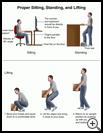
Proper Sitting, Standing, and Lifting at Work
________________________________________________________________________
KEY POINTS
- Sitting or standing for long periods of time can cause neck and back problems. Learn to sit correctly and adjust your workstation so that you don't put stress on your muscles and joints. When you stand, stand as straight as possible and try not to bend forward too much.
- If your job involves lifting, make sure you use the proper lifting technique to avoid injury. The key to proper lifting is to keep the natural curve in your back by squatting down rather than bending over at the waist.
- Take breaks throughout the day and stretch your neck and back.
________________________________________________________________________
What is the proper position for sitting at work?
Sitting for long periods of time, especially if you are using a keyboard, puts a lot of stress on your muscles and joints. It can cause neck and back problems, as well as overuse injuries, such as carpal tunnel syndrome. To help prevent injury, you can try to sit correctly and adjust your workstation according to the following guidelines:
- Keep your head and back straight, not tilted forward or back.
- Keep your thighs parallel to the floor. Your knees should be at a 90-degree angle and no higher than your hips. Keep your feet flat on the floor or on a footrest if needed.
- Use a chair with good lower back (lumbar) support for the normal curve in your back. For extra support you can use a lumbar roll, a small pillow, or a rolled up towel.
- Make sure there is a space of 2 to 3 inches between the back of your knee and the edge of your seat.
If you are using a computer:
- The monitor and keyboard should be directly in front of you.
- When using a keyboard, keep your elbows bent at a 90-degree angle. Your wrists should be in a neutral position, not tilted up or down. Use wrist rests for extra support.
- Set up your monitor so that when you look at it you do not:
- Turn your head to the side.
- Tilt your head back to see clearly.
- Tilt your head forward.
It’s important to take frequent breaks during your workday and to avoid sitting for more than an hour at a time. Whenever possible, leave your chair and walk or stand for a minute or two. Take a mini exercise break (1 to 2 minutes) every hour and a longer break (3 to 5 minutes), every 2 to 3 hours. During your break, stretch your neck and back.
What if I stand at work?
If your job involves standing for most of the day, you should:
- Put one foot up on a footrest (about 6 to 8 inches high) so there is less pressure on your spine.
- Stand as straight as possible to keep the proper alignment of your spine.
- Keep your work surface at or near waist level. Try not to bend forward too much.
- Wear sturdy shoes with good arch support.
- Do exercises to keep your back strong. Take breaks throughout the day and stretch your neck and back. Also do regular exercises that help strengthen your back and belly muscles. Ask your healthcare provider, physical therapist, or a personal trainer about these exercises.
How should I lift properly?
If your job involves lifting, make sure you use the proper lifting technique to avoid injury. The key to proper lifting is to keep the natural curve in your back by squatting down rather than bending over at the waist. To lift properly:
- Get as close to the load as possible.
- Stand with your feet apart, with one foot slightly in front of the other and your toes pointing slightly outward.
- Test the weight of the load first and get help if it seems too heavy or bulky.
- Bend your knees and squat down to a comfortable level.
- Lift the object and bring it close to your body.
- Return to a standing position by pushing up with your legs and buttocks.
- When you lower the load to the floor, use your leg and buttocks muscles to squat down. Keep your feet apart and keep the load close to your body.
Here are some other helpful hints:
- Don’t twist your back when you are lifting. If you have to turn, take small steps with your feet.
- Push or slide heavy objects rather than lift them.
- Keep objects close to your body when you lift, lower, or carry them.
- If lifting heavy objects is part of your job, talk to your employer about safety practices and devices that help protect your back.

